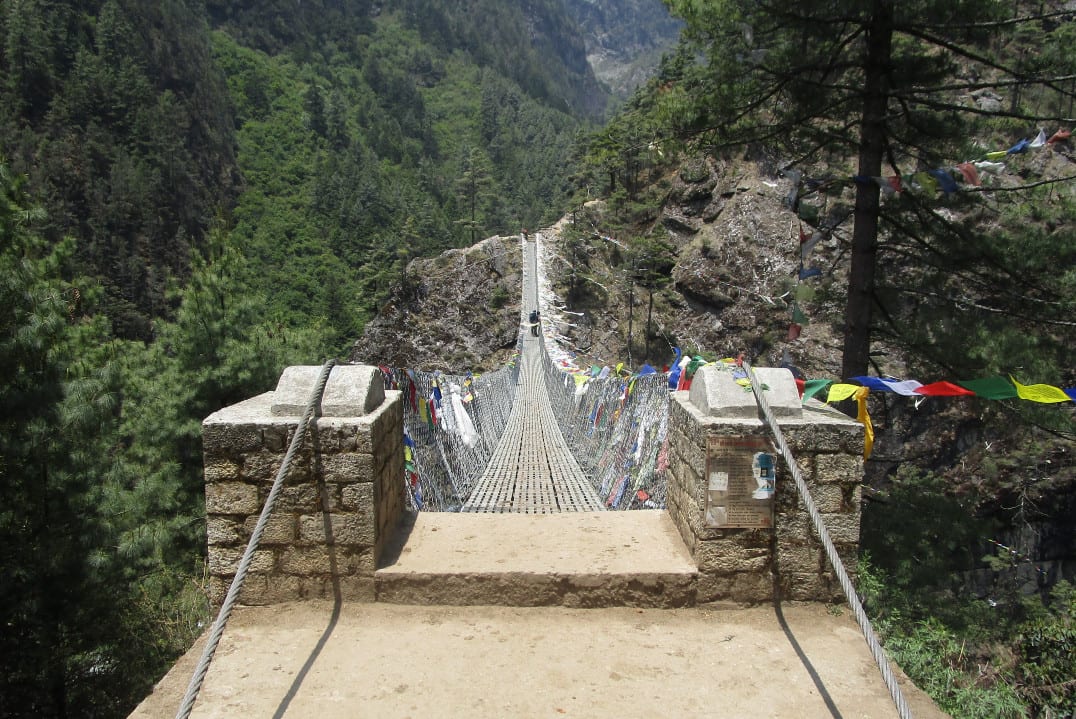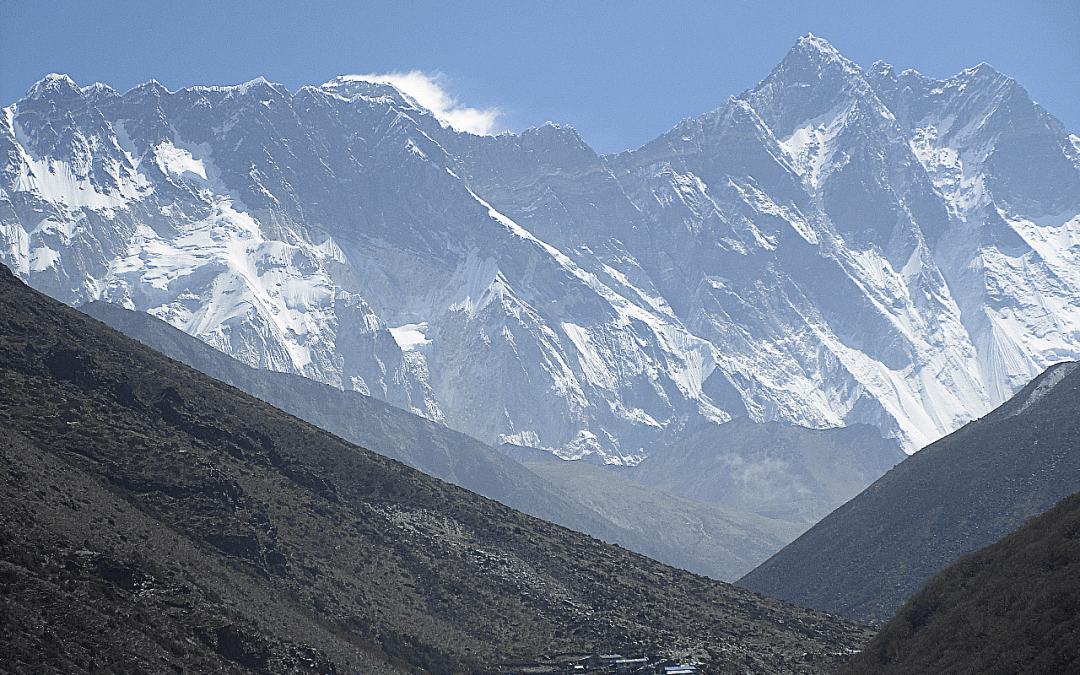Yes, you are correct, there are probably thousands of people who have written about their EBC Trek experience. I’m sure much of what is written is truthful, while some, probably not.
We at Prep4Travel are not here to feed you lies. We completed the EBC Trek and have put together 10 questions for you to ask and be answered. To get the ball rolling so to speak.
What we really want for you to get out of this article, is a good solid starting point. A helping hand with the decision making process. Our research and advice is from personal experience. We imagine you will have the same reactions to much of the experiences we did.
Our goal is for you to be prepared as possible, leaving the stress and worry behind. Your main focus should be to concentrate an enjoy the adventure that lies ahead.
How long is the EBC Trek (both in miles and hiking days)?
What is the best time of year to go?
How difficult is the trek?
What to pack?
What to expect?
What level of fitness is required?
What if I get altitude sickness?
Who should you book through?
Is it worth it?
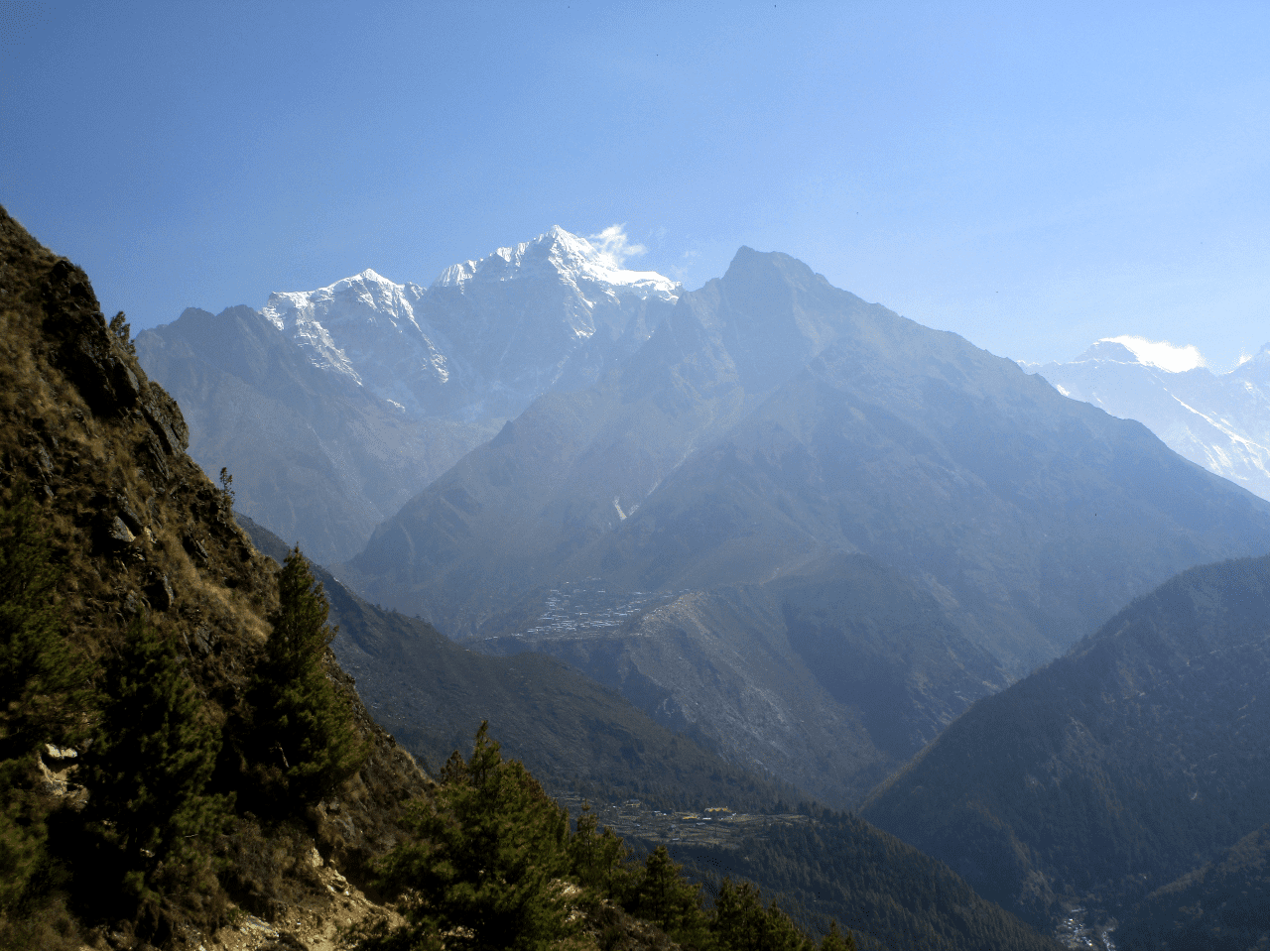
1) What does the EBC Trek cost?
$1500 is a good ball park # to start with. While this might seem pricey, you will be getting quite a bit included in this cost. This price will vary upon shorter or longer treks, add ons, and tour operators. But at this price point you will be getting good value for your money.
This is what to look for in the cost of the trek:
– pickup in Kathmandu (Tribhuvan Airport) upon arrival to Nepal
– 1-2 nights in a recommended hotel by your tour operator prior to the trek
– transportation to the start of the trek (this could be a combination of bus to several different smaller airports for the flight into Lukla, or possibly a direct flight from Kathmandu to Lukla.
– a guide and porter for the entire trek
– 3 meals a day while the trek lasts
– lodging each night while the trek lasts (figure on roughly 12 nights for the actual trek)
– entrance fees to each national park you trek through
– transportation back to Kathmandu once you complete your trek
– 1-2 nights in a recommended hotel before departing Nepal
– transportation to the airport day of your departure flight
Remember, international flights are extra. Tours in Kathmandu are extra. Food and shopping pre and post trek are extra.
If your Sherpa is not included in the trek cost, then we recommend you find a tour that includes a Sherpa, or pay for one if your chosen tour operator does not include one. VERY worthwhile. Not only does it free you up to enjoy the trek itself, but you are also supporting the local economy.
These Sherpas rely on the work to support themselves and families. One day of carrying your 50 lb duffel bag up these steep trails, not only will you be thankful for your light load, you will appreciate the insane amount of work it must be for them.
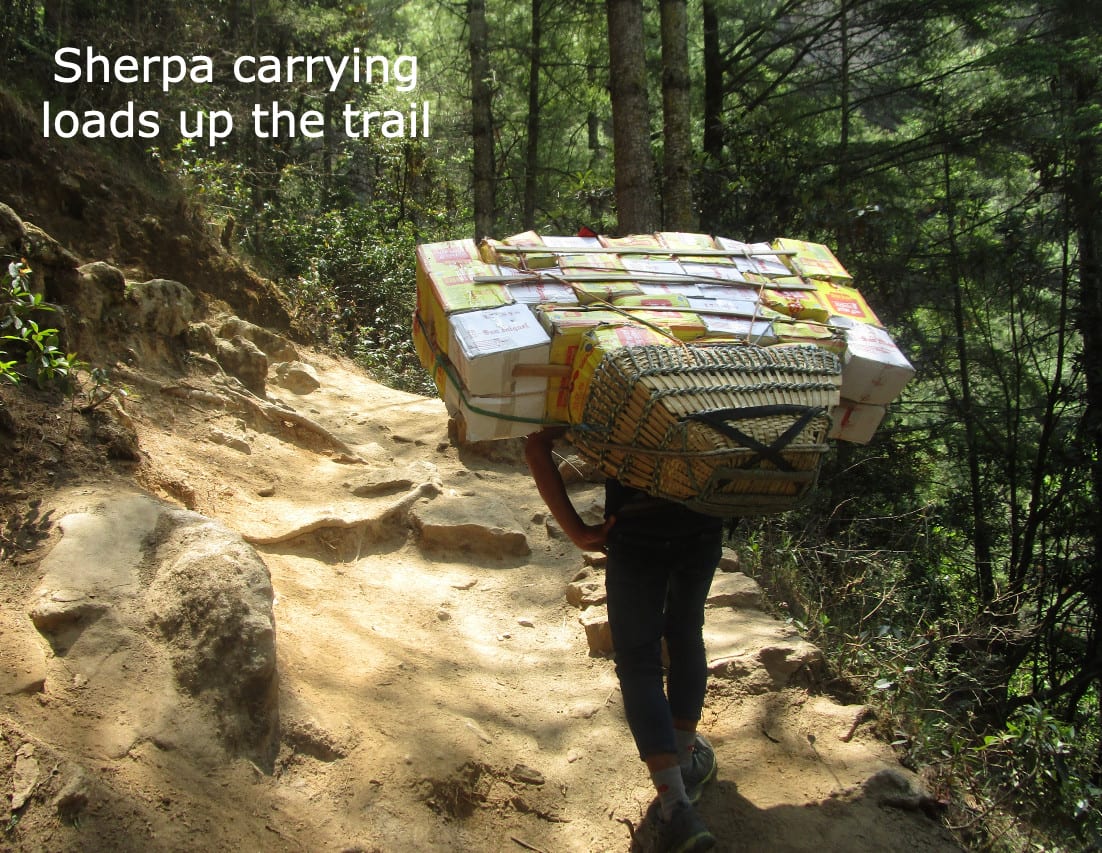
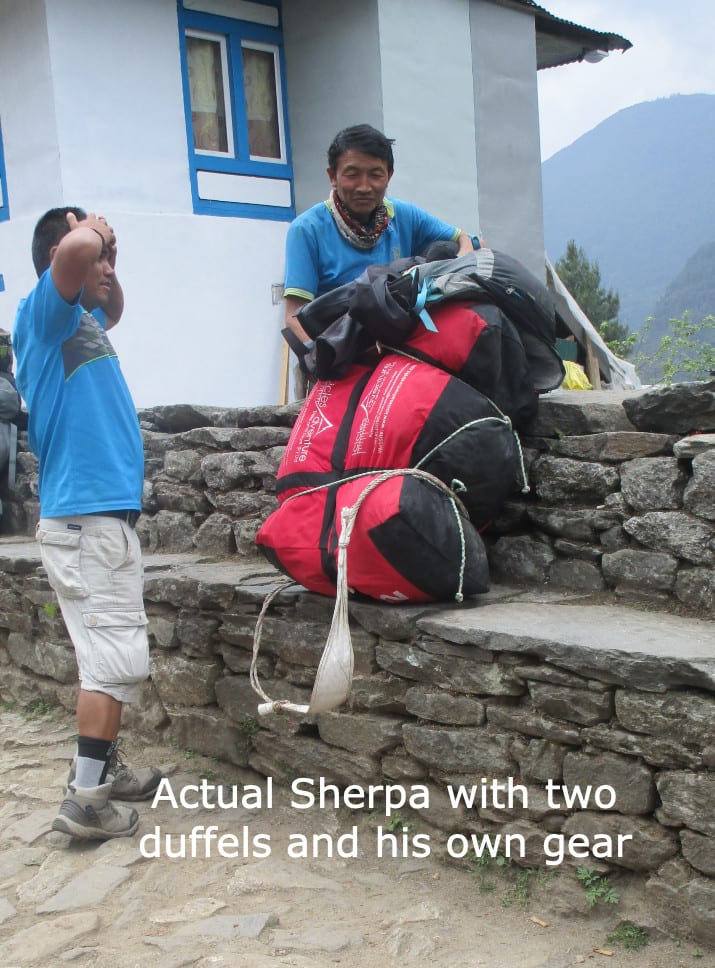
2) How long is the EBC Trek?
Total hiking distance is 80 miles (40 each way) or 130 km.
Maybe this distance doesn’t sound like a lot for a two week trek, but we would argue otherwise. The 40 miles on the way to EBC, will feel much longer with the elevation change. You will spend hours trekking upwards, where your only thought is’ when will I hike on flat land again’.
The actual trek can be completed in whatever time frame you desire. Your tour operator puts an itinerary together with recommended overnight stops and acclimation days. Most trekkers take around 12 days to complete the round trip trek. Usually 8 days to get to Everest Base Camp, then 4 days for the return to Lukla.
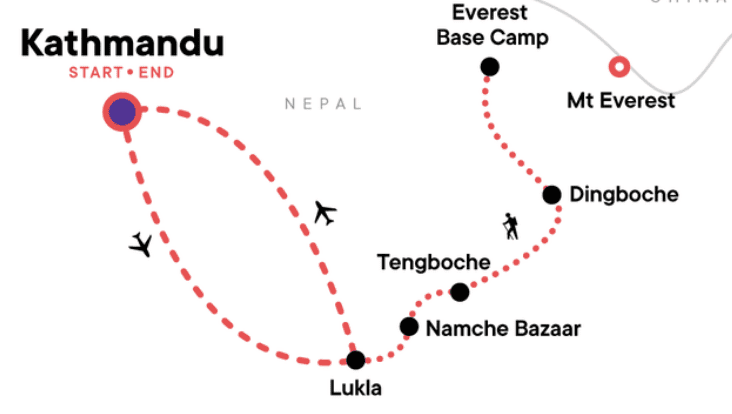
3) What is the best time of year to go?
April/May or September should be your first choice months to go. April/May tend to be after the winter thaw, yet before the wet season hits. September is after the wet season but before the winter cold and snow hit. We completed the trek in May and only had about 3 hours of rain on our very last day.
Please remember, the EBC Trek launching city of Lukla can ONLY be reached by airplane and or hiking trail. Therefore all flights in and out are 100% weather dependent. It’s not uncommon for flights to be delayed hours or even days until the weather has cleared enough for safe takeoffs and landings. This in turn can lead to delays both pre and post trek.
We were supposed to fly direct from Kathmandu to Lukla, but due to inclement weather conditions, our flight from Kathmandu to Lukla was cancelled. Our tour operator ended up putting us on a 4 hour bus ride through the Himalayas. We had to fly out of a tiny airport called Mathali Airport. The flight from Mathali to Lukla was about 45 min. It’s best to just go with the flow, as much is out of your hands.
4) How Difficult is the Trek?
We would certainly classify this trek as hard/difficult. No, you do not need actual climbing gear, but the terrain changes quite a bit. From dirt paths to lose gravel to giant stone. A novice or beginner hiker would be best to try other more modest treks/hikes before attempting the EBC trek.
Elevation is also a significant factor. Not only is the elevation change a hiking challenge to be going up up up, but it can cause altitude sickness. The EBC trek starts off at 9383 ft, and you will end up getting close to 18000 ft. Everest Base Camp itself is 17598 ft. You will have to hike up a ridge and cross it before traversing down to EBC.

5) What to pack?
This is where your Sherpa is going to pay off big time. Make sure it’s included in the trek cost. They will carry your main bag (duffel). Up to 50lbs (25 kilos). This isn’t a green light to go crazy and over-pack. Take a main duffel bag for your Sherpa, and a backpack for yourself. These our are recommendations:
Duffel:
- pair of flip-flops, sandals, or light shoes (for the evenings)
- thick downed sleeping bag (some tours provide) + small pillow
- long underwear (top & bottom, probably 50/50 on if you will need it)
- 2 pairs of trekking pants
- 3-4 wicking hiking shirts
- 1-2 long sleeve shirts
- 1 hooded sweatshirt
- 1 light rain jacket
- 3-6 pairs of hiking socks
- 1-2 pairs of athletic socks
- 2 weeks of underwear (whatever that is for you)
- 1 hiking vest/fleece
- ablutions kit
- small shower towel (showers and hot water are not always available, but if you get the chance, you want to be ready)
* Please keep in mind, your Sherpa is taking your duffel at the start of every day. Make sure you have everything you need for the day with you in your backpack. There is a good chance you will not see your Sherpa until the evening when you reach your next nightly accommodation.
Backpack:
- trekking poles (highly recommended)
- camera, phone, charger
- hand towel (mop up sweat)
- sun tan lotion
- hiking hat
- bug spray (we didn’t need it)
- sunglasses
- 1-2 water bottles (we used 1 and refilled often)
- extra pair of hiking boot laces (just in case)
- an analog watch
- book/magazine (for any downtime)
- take along both US, and local currency (Nepalese Rupee), you will need to purchase water, snacks, and souvenirs along the trek, also tipping your guide and Sherpa at trek end is recommended
- a really good solid sturdy comfortable pair of hiking boots (we put insoles in ours)
- bring along a 1/2 roll of toilet paper. The tea houses (what your nightly accommodations are called) should have functioning washrooms, but just in case it’s good to have your own backup plan
6) What to Expect?
This trek will likely exceed your expectations in more ways than one.
Nepal is a beautiful country with the Himalayas at its fingertips. Snow capped mountains, Nepali villages, unimaginable scenery are all trekking experiences you can’t hide from. It’s best to go with an open mind.
Yes, Nepal is still considered a developing nation (3rd world), landing in Kathmandu isn’t like landing at LAX or O’hare in Chicago. We recommend you arrive at least 2 days before your trek starts. Gives you time to catch up on some jet lag, and to book a tour or two of Kathmandu’s best attractions.
Also if you are afraid of heights, either don’t do this trek, or use it to challenge yourself to get over your fear. You will have to cross multiple cable bridges suspended hundreds of feet above rivers and ravines.
There is also the flight into the trek launching city of Lukla. This mountain city airport is considered one of the most dangerous in the world to land. I mean, it’s on top of a mountain, so of course the landing and takeoff have to be right.
This isn’t to make you nervous, it’s to inform you that you will be flying on a small twin prop plane carrying 15-20 other trekkers. Due to the air pockets in the Himalayas, you will likely experience a little bit of turbulence.
Fortunately these pilots have done this flight over and over again, and are well trained. Chalk it up as part of the adventure!
* Take a sec to watch this short video on the flight into Lukla. The last minute is the best. Flight into Lukla (watch the first 6 min)
7) What level of fitness is required?
You don’t have to be a marathon runner to complete this trek. We do however recommend you try to be in half decent shape before attempting.
Start up a bit of a training routine a few months in advance. If you have access to a stairmaster or treadmill, spend 30-60 minutes a few times a week on it. You don’t have to run a 4 min mile. Set your treadmill on an incline and go at an even pace. Jogging or even walking is fine. The point is to train some of your muscles for the motion of going up, like you will quite a bit of the trek.
You will typically hike 6-8 hours a day (this partly depends on how fast a hiker you are). As mentioned previously, lung capacity will be an issue due to the change in altitude.
Altitude sickness affects people of different fitness levels in different ways. Please check out what altitude sickness is here.
If you have done any trekking or hiking in the past, you should be able to gauge how well you can handle rough terrain, elevation change, and hiking at altitude.
8) What if I get altitude sickness?
This is why most tour operators build 2 acclimation days into the trek: to help avoid or cope with possible altitude sickness.
Our tip for helping with this is ‘Hike High, Sleep Low’. This simply means when you get to your end destination for the day, unpack, relax, and go on a light stroll higher. Meaning spend 30 – 45 min at a slow wandering pace and work your way upwards. Concentrate on breathing and taking your time. Then hike back down to your place of rest for the night. This certainly helped us.
If for some reason you do get altitude sickness, it’s nothing your guide hasn’t seen before. Most tour operators will not allow you to trek unless you have trip insurance for that exact scenario.
It has happened to trekkers (and certainly Everest climbers) where they need to be moved by helicopter to a lower altitude. Again, don’t let this discourage you. Make sure you have trip medical insurance just in case!
You can also talk to your doctor about prescription altitude sickness meds. There is also an over the counter option. We have not used these, but have heard from others that they help. Rx Oxyboost
9) Who should I book through?
There are many great tour operators that offer the classic EBC Trek, usually in the 14-15 day range. We’ve already discussed what should be included in your trek cost.
Our recommendation is G Adventures as a great tour operator for this trek. G Adventures specializes in adventure travel, and their price point is about in the middle of what operators charge for this particular trek.
They have great reviews, and can be trusted. Paying too little for this trek, you likely won’t get the service needed, while no one wants to pay too much!
Click on the below link or picture to check out GAdventures. Just type Everest into their search box and Trek options will pop up.
10) Is it worth it?
ABSOLUTELY. If you are any sort of hiker, the EBC trek can be considered the pinnacle of your hiking career.
We remember after finishing the trek and flying from Lukla to Mathali and the proceeding 4 hour bus ride back to Kathmandu like it was yesterday.
We sat in this surreal state of ‘did we really just do that’? Our brains were trying to process and comprehend our past two weeks from non stop input of sights, sounds and memories. We have zero regrets and it has only led us to want to hike and explore more corners of the earth.
If you have thought about this trek, and are sitting on the fence so to speak, we hope we have nudged you to fall on the EBC Trek side. You will love it, thrive on it, and remember it forever.
Have more questions you need help answering? Please don’t hesitate to email us: Prep4Travelinfo@gmail.com
Interested in other treks? Check out our article on the Inca Trail Hike.
